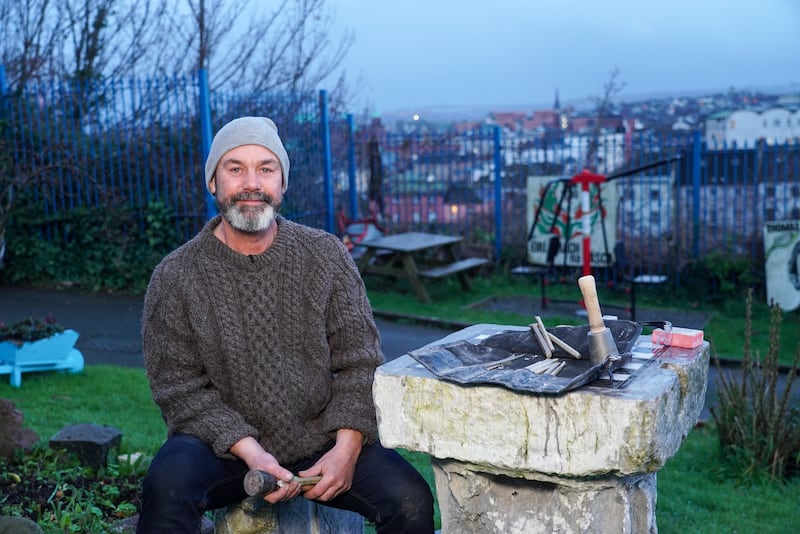I never went to an art gallery before the age of 40. I felt intimidated by the culture. I had this idea that art had to be a certain way and you had to speak a certain language. Now I’m a stone carver. One of the most beautiful sounds in the world is when you have three or four people all working on different-sized stones, and the pitch from each stone is different. Ta-ting, ta-ting. Ta-tung, ta-tung. It’s a thing of beauty.
I’m 53 and I’m from Fermoy originally. I grew up with a love of nature that I got from my dad. It felt quite normal for me to be at the banks of the river, lighting fires and fishing. It was a big part of my early life.
School was an absolute disaster for me. It was the way that they taught. I had an extremely creative mind – I can say that now – but I didn’t know that when I was younger. At the age of 27 I started restoring stone walls of big houses built during the Famine around Blackwater Valley. Non-native beech trees have a habit of falling over. They’d damage the walls and I’d get a call.
Then I got into working on building sites too. I really hadn’t found my calling at this stage. But then the 2008 crash came, I was inside the social welfare office one day and I decided to give this education thing another go, taking up a course in organic horticulture. Soon I was working with a probationary service teaching others how to grow vegetables. We’d grow a bit of lettuce and a few tomatoes that would go into a cafe. I absolutely loved it. I was growing as well.
READ MORE
But I knew there was more to me. I used to mess around and sharpen down an old screwdriver to see if I could make a mark on a stone. There was something f**king dying to get out of me.
When I turned 40 I participated in a stone carving weekend on the Aran Islands. I thought, if I could put one letter on a stone, I could die a happy man. I came off the island with a stone that said Amazing Grace. I went back to work full of passion for stone carving.
There’s always been a desire for us to leave our mark on stone. It goes back thousands of years. Stone is so linked to us: it keeps us dry in the evening; our houses are built from it; when we pass away, we’re left with a stone to mark who we were. I’ve worked with people creating stones for people they’d lost. One had a pair of pliers carved into it; another had a vacuum cleaner.
I primarily use tungsten-tipped chisels and a hammer to carve stone. I use a lot of angle grinders and electrical stuff too. Sometimes people say, “Jaysus, this is so slow!” But it’s about time, the smell of the stone, the rhythm, the sound. Hours can go by.
I’m working a lot now with Cork Simon Community and we made chess tables for the city last year. I found a discarded column down in a council yard in Mahon. It was forgotten. It’s the vision of creating something by marginalised community groups and handing it back to the city. With the lads in Simon, there might be a perception that it’s a one-way street. But they’re so proud to be from Cork and want to give back.

[ ‘We’re the original recyclers on the island’Opens in new window ]
This year is even more exciting. We’re after getting stones from Valentia Island, the most westerly quarry in Europe. We’re going to work on them for a project in the coming months. Not only will there be sculptures, but it will be a biodiversity garden. We’re trying to bring nature back into the city.
I also work with Cork Life Centre, an alternative education centre for teenagers. I help the students manage a garden, growing vegetables and flowers. With all the talk about climate change, it can sometimes be very daunting for our young people. We can teach them that even growing a small bed of vegetables or carrots: that’s making a massive difference to the environment by saving on food miles.
I teach stone carving there too. I recently acquired a lovely bit of Cork limestone from the Port of Cork and sliced it into small slabs for the kids to work on, probably doing Celtic knotwork.
The kids often arrive feeling like they don’t belong in an education system. A lot of mainstream education fails the young person and blames them. We use a much more holistic approach here and the class sizes are smaller. I have seen kids walk in that gate with their heads down, and four or five years later they’ll leave for third-level education or work with their heads held high.
I also work with private clients at weekends out of Cork Life Centre. We’re keeping the skill alive and bringing it to new levels. We’re not just trying to preserve an old tradition, we’re blowing it out of the water. – In conversation with Conor Capplis
tommylysaght.ie


















